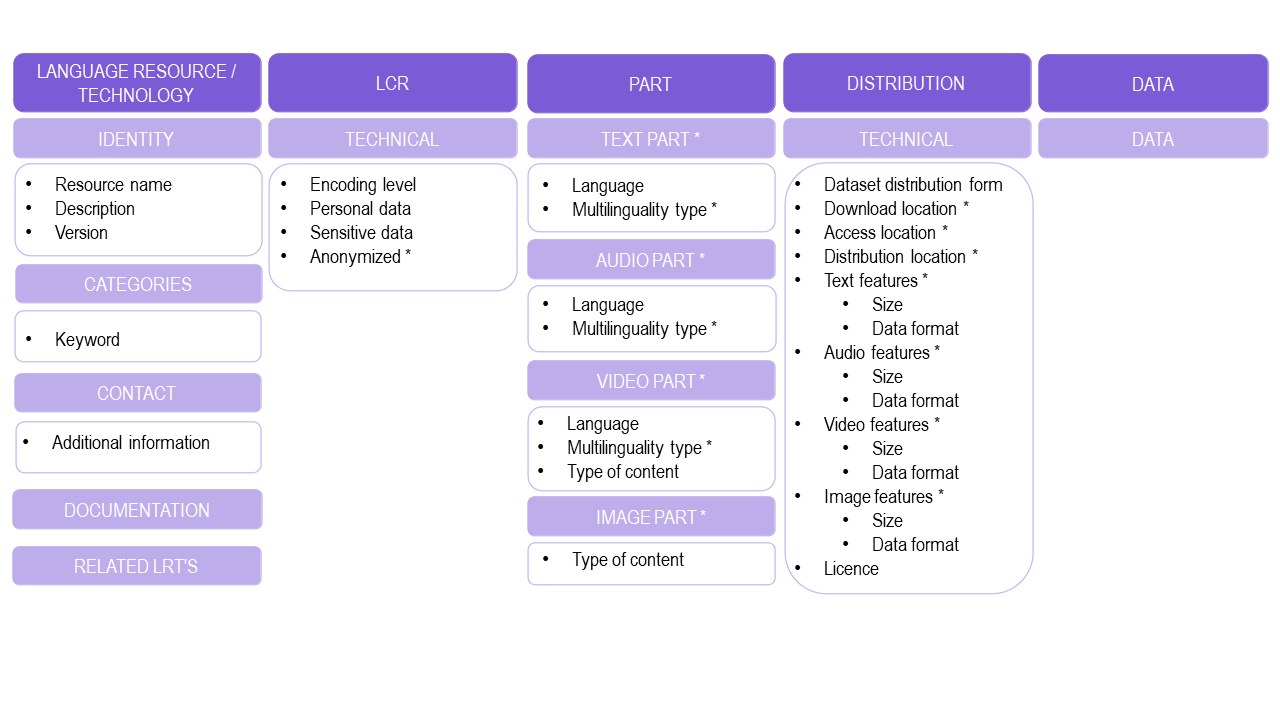Contribute a lexical/conceptual resource¶
This page describes how to contribute a lexical/conceptual resource to the European Language Grid. You can describe it and upload its contents at ELG or include in its description a link to the location it can be accessed from.
0. Before you start¶
Please make sure that the lexical/conceptual resource you want to contribute complies with our terms of use.
Please make sure you have registered and been assigned the provider role.
1. Prepare the content files (for ELG hosted resources)¶
If you wish to upload the resource at ELG, you must package it in a compressed format (currently as a .zip, .tar or .gz file).
Tip
If the files are available in multiple formats, (e.g. in XML, TXT and PDF formats), you are advised to package them in different archive files by data format and describe them as distinct distributions.
2. Describe the lexical/conceptual resource¶
You can register the item (i.e., the metadata record and, optionally, the content files)
using the ELG interactive editor (see Use the interactive editor), or
by uploading a metadata file that conforms to the ELG schema in XML format (see Create and upload metadata files).
To upload the content files for the lexical/conceptual resource, you can follow the procedure described here.
The following figure gives an overview of the metadata elements you must provide 1 for a lexical/conceptual resource, replicating the editor (with sections horizontally and tabs vertically) so that you can easily track each element. In the editor, all elements, mandatory or not, are explained by definitions and examples.

To describe any resource efficiently you need to name it, provide a description with a few words about it and indicate its version 2. Then, one or more keywords are asked for the resource and an email or a landing page for anyone who wishes to have additional information about it.
For lexical/conceptual resources, you must also specify the encoding level of its contents (i.e., whether it contains morphological, syntactic, semantic, etc. information), and whether personal or sensitive data are included. If this is the case, you must say whether they have been anonymized.
You also have to describe independently each distributable form of the resource (i.e. all the ways the user can obtain it, e.g., in a downloadable form, or accessed through a data service). For each distribution, you must always specify the licence under which it is made available. In case you decide not to upload the content files at ELG, you must also include a link to the point it can be accessed from (download / access location 3 ).
Your lexical/conceptual resource consists of one or more media parts (namely: text, audio, video, or image parts). Each of these parts must be described separately. For instance, if you have a multimedia lexicon (e.g. with videos for a sign language and its translation into another language), you must provide separately information on the language(s) of each part and their respective distribution features (size and data format at least). The figure shows the mandatory and mandatory if applicable elements for each type of part and distribution feature group.
3. Manage and submit for publication¶
Through the My items page you can access your metadata record (see Manage your items) and edit it until you are satisfied. You can then submit it for publication, in line with the publication lifecycle defined for ELG metadata records.
Before it is published, your submission undergoes a validation process, which is described in detail at CHAPTER 4: VALIDATING ITEMS.
Once approved, it will appear on the ELG catalogue and you will receive a notification email.
- 1
You must fill in at least the mandatory elements for the metadata record to be saved. In addition, you may be required to fill in specific mandatory if applicable elements (indicated in the figure with an asterisk), depending on the values you provide for other elements.
- 2
If no version number is provided, the system will automatically number it as “1.0.0” with an indication that it has been automatically assigned. We recommend, however, the use of Semantic Versioning (https://semver.org/) for labelling versions.
- 3
The two elements differ in terms of the actions that a consumer has to undertake in order to access the resource. Use download location to provide a direct link to the content files; no actions are required on behalf of the user who can simply download the file(s). Access location is typically a page with some text, which includes a button or a link for accessing or downloading the resource itself; the user must read through the text on the page in order to find the link.